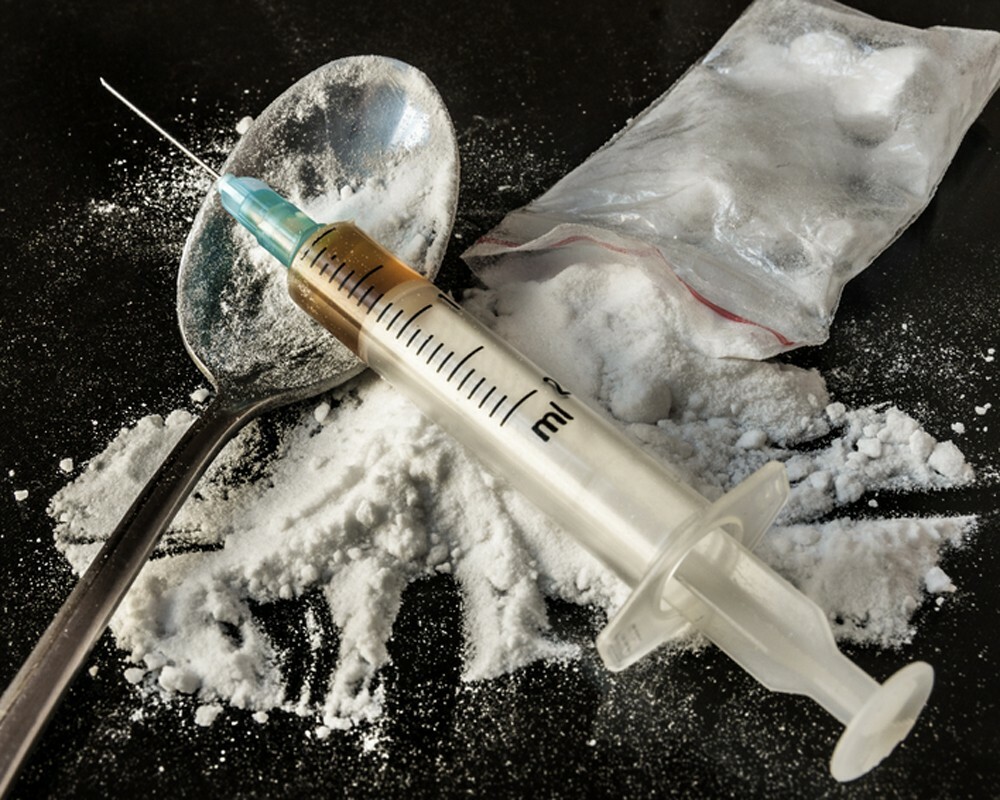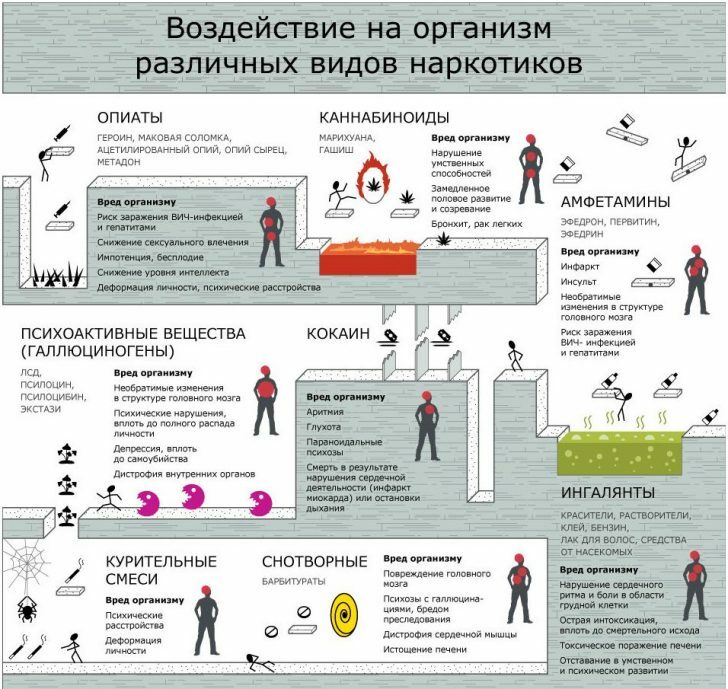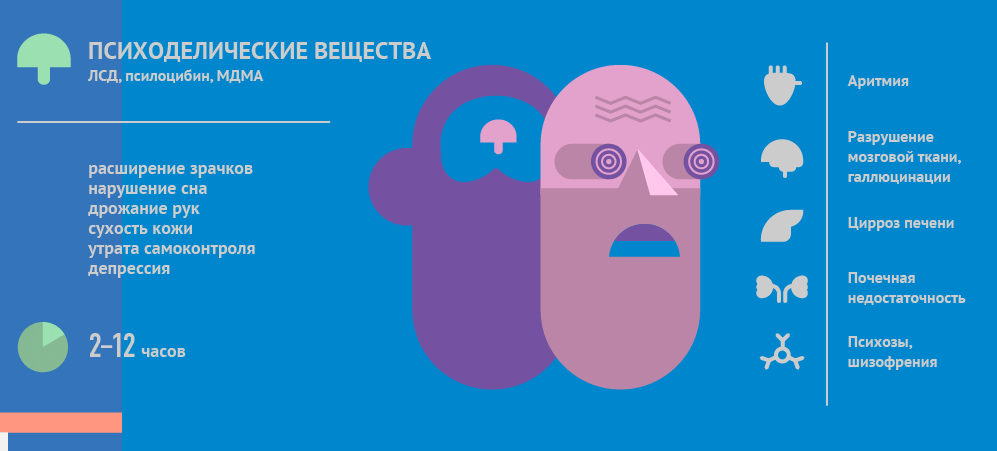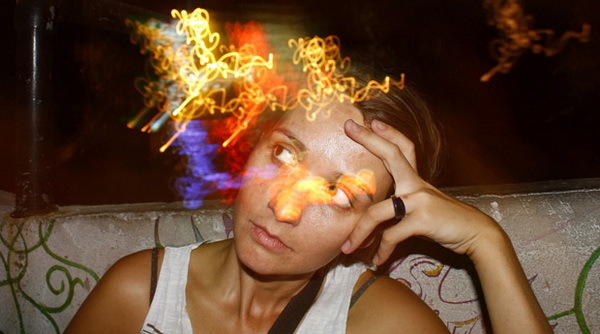Types of drugs and their effects
 Substances and drugs that cause drug dependence, there is a very large number.To consider each of them, you will need to describe the material in the size of a large book, so we will touch only on the most basic drugs, causing a painful addiction.
Substances and drugs that cause drug dependence, there is a very large number.To consider each of them, you will need to describe the material in the size of a large book, so we will touch only on the most basic drugs, causing a painful addiction.
Dependence development in the sedative drug group
The principles of dependence development on the sedative group will be analyzed in detail with the example of the most common narcotic "potion" - opiates.

Opium is the most ancient of all known drugs.History has preserved the traditions of him as a medicine.The poppy heads are immortalized in the mythical legends of the countries of the eastern Mediterranean, the Sumerian tables, the works of Hippocrates and the descriptions of Alexander the Great's campaigns.Opium became known throughout the world and was used from those times to the present day.
Opium alkaloids are widely known in our country in the form of juice, tinctures, powder, plastics.Opium substances are identified - Morphine, Codeine, Heroin.Synthetic variants of opium have been created - Methadone, Meperedin, Fentanyl, Tramal, etc.
In everyday life, addicts usually use "kitchen options" - derivatives.It is not possible to describe all forms in this article, therefore, let's consider the most common ones.
Note: narcotic effect causes a usual therapeutic dose of these substances.
Drug reception is accompanied by:
- Phase 1 - "arrival", waving warmly over the body, "bursting" with joy, ease of thought, etc.Duration of sensations about 5 minutes;
- 2nd phase - A person who is under the influence of a drug is inactive, experiences hallucinations, visions( illusions), the duration of the condition is 3-4 hours;
- 3 phase - sleep - 2-3 hours;
- 4 phase - aftereffect - poor state of health( pain, nausea, dizziness, dreiness, etc.).
Note: for opium intoxication is characterized by a narrowed pupil.
The dependence develops very quickly.The first injection almost always goes well, without consequences.
Attraction occurs from the reception:
- heroin through 3 to 5 injections, sometimes immediately;
- morphine after 10-15 injections;
- opium( tincture) about 2 to 3 weeks;
- codeine - after 1 month.
This is both a regular and an irregular reception.
stages The disease develops in three stages:
- During the of the first stage, the symptoms of altered reactivity( change in the action of the substance and the complex of the body's reactions) appear, a systematic reception occurs, gradually the itchingIntoxication), a mental desire is formed.The duration depends on the drug and ranges from 1 month to several years( in rare cases).The dose of the drug is increasing.
- The second stage is characterized by a formed reactivity syndrome.Obsessive attraction( long and constant desire) reaches a maximum, tolerance( resistance to action, accompanied by a decrease in the narco effect) is increased, forcing to take the drug in huge doses 100 to 300 times higher than therapeutic, in case of morphine, heroin - up to 20 times, codeine - 150- 200 times.The sensations of the "arrival" are gradually erased.Addicts try to combine drugs in a sophisticated way to achieve the effect of euphoria( rainbow joy and physical overcomfort).Patients manifest a pronounced compulsion( a pronounced physical craving capable of "extinguishing" all other needs, including sleep and a feeling of hunger) and developed abstinence( severe physical and mental condition when depriving the drug).Some patients are still able to withstand a certain dose.
- The third stage is manifested by severe physical health disorders caused by chronic drug poisoning.Before this stage, an insignificant number of drug addicts, especially heroin survivors, live.
Note: is a characteristic sign of the development of III stage is the disappearance of the soothing effect of the drug and the appearance of a toning .
At the last stage, the doses are reduced, as the tolerance of the drug becomes lower.Approximately one tenth of the usual dose is able to remove the abstinence from the patient, which proceeds very hard at this stage and occurs earlier than at stage 2.Patients are physically depleted.
The onset of withdrawal is 4-5 hours after the last use of the drug.Its peak comes on 4-5 days and lasts about 2 weeks, then gradually converging to "no."Consequences in the form of weakness are felt for several months.After the termination of anesthesia and withdrawal from withdrawal, severe physical and mental disorders( heart rhythm disturbances, intestinal problems, pressure drops, depression, sleep disturbances, etc.) are observed for a long time in patients. Complaints are very diverse.
Opiomania is a continuous process.Attempts to leave the drug on their own usually end with a breakdown at 2 - 3 weeks of a sober life.Hold for a year, according to various sources, it is possible from 8% to 50% of patients.
How do opiates work on the brain?The answer to this question in his lecture is given by D. Dubynin, Doctor of Biological Sciences:
Features of methadone dependence

Methadone - a synthetic opioid, opened in 1947, is used in some countries as a drug of "substitution therapy" for patients treated fromHeroin and morphine dependence.Methadone for these purposes is taken orally at doses of 30 to 120 mg per day.
Some drug addicts start with Methadone their "narcobiography".Its effects are the same as that of all opiates, but they are less pronounced, as is the withdrawal syndrome.
Note : a distinctive feature of the action is a strong influence on the brain, which begins to suffer more and more quickly than when taking other opiates.
Patients suffer from marked mood swings, aggressiveness, spitefulness.

The development of dependence on the use of sleeping pills
The most popular among addicts among sleeping pills are barbiturates. The history of the abuse of these medicines is recent, it is called the "disease of European civilization".The number of patients with barbiturate dependence is constantly increasing.
Note: does not cause any drug with a hypnotic effect to cause addiction .
Usually, to achieve the drug effect, 2 to 3 therapeutic doses of hypnotics are sufficient.
Narcotic effect of hypnotics proceeds in several phases:
- 1 phase of intoxication - "arrival", is expressed slightly and only for beginners, lasting several seconds.
- 2 phase causes causeless fun and erratic activity.It can take about 2-3 hours, both in the form of joy and aggression.
- 3 phase - a heavy sleep, lasting 3-4 hours.
- 4 phase - awakening - "stupefied".
Abuse of sleeping pills develops in people with mental disorders and is forced to take this group of drugs without medical supervision.
Another category of addicts starts taking sleeping pills on their own - to achieve a narcotic effect.Addiction develops very quickly, usually within 4-6 weeks and requires a dose increase, and a month later develops a physical dependence( compulsive attraction).Receiving Amidol sodium in doses of 0.6-0.8 g leads to it within a month or two.Obsession( constant thoughts about the desire to take the drug) is poorly expressed.
I stage dependence lasts up to 4 months, the effects of intoxication are close to the therapeutic effect, the timing can vary from several weeks to years.
In the II stage, the dose is set at a certain level, but it is required daily, there is aggression and memory dips.Abstinence occurs one day after the last reception of barbiturates, its duration is 4-5 weeks.
Stage III of the can only occur in cases of drug addiction increases and is very rare.
Note: addicts III stage in the majority begin to combine taking sleeping pills with other substances, alcohol.
 Patients with barbitur drug addiction early get complications from internal organs and psyche, outwardly they look pale, exhausted, edematous.In the case of wounds on the skin, their healing lasts a very long time and is accompanied by purulent complications.Blood pressure is reduced.The behavior of drug addicts changes roughly, due to developing encephalopathy.
Patients with barbitur drug addiction early get complications from internal organs and psyche, outwardly they look pale, exhausted, edematous.In the case of wounds on the skin, their healing lasts a very long time and is accompanied by purulent complications.Blood pressure is reduced.The behavior of drug addicts changes roughly, due to developing encephalopathy.
Patients with advanced stages of barbituromania are difficult to treat due to developing dementia( brain damage with deterioration of all functions of the nervous system and psyche).There is a pronounced social disadaptation of patients.Remissions( periods of abstinence) are very rare.Many become polytoxicomans( taking different drugs).
Dependence on sedatives
Tranquilizers takes up to 5% of the world's population.The special distribution of this group of medicines began in the 1950s.
The dependence develops as in barbiturbation - in two ways:
- The first is an uncontrolled reception for diseases - neuroses, fears, stresses, which cause a person to use something soothing.Usually these patients are 40 years old.
- The second is drug addiction, in which a person pursues the goal of achieving a narcotic effect.In most cases, tranquilizers take the place of polytoxicomania( the use of sedatives is combined with additional narcotic substances), as "clients" begin to search for substances that give a more pronounced narco-effect.
Tranquilizers, unlike opiates, do not change the biological structure of the body, resulting in less physical expression.The picture of drunkenness by tranquilizers is similar to that of sleeping pills.
In order to achieve a drug effect, the dependent takes from 5 to 10 tablets of the drug.The most popular drugs are Radedorm and Sibazon, the rest are less likely to be selected.
In addiction with the use of tranquilizers, the sphere of emotions suffers most.Memory is lost, psychopathy develops.Affected internal organs.

The course of dependence on tranquilizers is generally milder and longer than with opiates, but the consequences are also terrible and depend on the age of the addict, the duration of the tranquilizer, and the combination with other addictive substances.
Features of the development of addiction to stimulants
Stimulants include a large group of drugs that have emerged relatively recently.The thirst for "adrenaline" sensations pushes many today to experience these substances on themselves.The first "project" of this group was "crack" - the derivative of Cocaine .The stimulants include tea with coffee, cocoa, cola nuts.
Artificially produced amphetamine , a derivative of the modern Ecstasy .
Let's try very briefly to understand the development of drug addiction caused by this group of substances using the example of Cocaine.
Cocaineism swept Europe at the end of World War I.The next wave was in the 70s of the XX century.In our country, cocaine was used mainly in processed form called Ephedrine, in the artisan variant - "screw".The use of these substances in doses that cause a narcotic effect is accompanied by a sense of clarity of consciousness with bright colors, a surge of strength and creativity, special sensations and a specific perception of the environment.
The duration of such intoxication is up to 6 hours, depending on the substance taken.
Adaptation to stimulants is formed, as in all cases - in three stages with the development of mental dependence( 1 item).The need for a drug because of growing resistance( tolerance) can raise the initial dose by 60 times.
Note: is a feature of getting used to stimulants, is that this kind of addiction comes to the forefront of the syndrome of mental dependence.It is formed much faster than the syndrome of altered reactivity develops.The latter is already formed on its background, as if in parallel, but slightly behind.
1 stage lasts up to one and a half months.
With the onset of II stage , obsessive craving for psychic dependence almost disappears, but the compulsive attraction of physical dependence, which begins to form at the end of the 2nd week of drug use, sharply appears.Attraction is so powerful that patients become uncontrollable, capable of everything for the sake of getting a drug.

III stage is accompanied by a decrease in doses.Intoxication is practically absent.The dose of the drug is needed for a simple arrival in the "norm".Drug addicts are psychopathic, semi-irascible, incapable of purposeful activity.Social adaptation of these patients is very difficult.
Dependence on psychedelics
The effects of these substances have been written since pre-Homer's times.Circe "bewitched" the satellites of Odysseus precisely with psychedelics.
The classification of this group is quite extensive.These include - Mescaline, LSD, hashish( marijuana, cannabis), ketamine, volatile substances "LNDV".Among the youngest admirers of drug-use glues, acetone, oil products are used.

The action of psychedelics lies in euphoria, perception disorders and thinking, therefore they are called "hallucinogens", "fantasies".
They are used in many different ways.Basically in tablets, smoking, sniffing.
Note: is the most common type of addiction in the world is hashism.
It is impossible to set the dose of this substance.They are usually determined by eye.
On the effect of hash on the human mind, you can write a whole book, so peculiar and diverse are the narcotic effects caused by this substance.They concern both external visions and internal sensations - unusually bright and clear, combined with benignity and ease in the body.The conversation of people may seem rustling leaves, etc.

Overdose of hashish causes psychosis.Gradually the dependence is formed( in a very individual time order), then the 1 stage of hashishism develops, lasting 1-2 years, with a psychic attraction( obsessive craving), II stage gradually begins with physical dependence and development of compulsive drug addiction,Sweeping away all other human desires. III stage hashish is formed after 10 years of regular smoking.Complaints with her are the same as with other addictions in this final phase.
How do psychedelics, in particular LSD, act on people, how dangerous is the use of these drugs and how fast addiction forms?Answers to these and other questions are in the video review:
Politics
The use of one type of narcotic substance is peculiar to beginning drug addicts, afterwards most of them begin to jump from one type of dependence to another, or use several substances at the same time.Often the reception of the opium group is combined with alcohol, tranquilizers.The combinations of polytoxicomania are very diverse, they change complaints, clinic of illness, heavier prognosis and treatment.
Important: , there is an allegation of alleged "light" drugs.It is a myth.No lungs!
In the schematic form, the action of the most common drug groups is described in the figure:
Display »

Is it possible to recover from addiction
 Treatment of this disease is a very difficult and time-consuming task.The earlier the healing process is initiated, the better its result.The treatment should involve both the doctor and the patient, and the entire environment - relatives, friends, acquaintances.The patient needs to completely change his life for success, sometimes to go to another place where there will not be a familiar situation that is directly related to the existing drug addiction.
Treatment of this disease is a very difficult and time-consuming task.The earlier the healing process is initiated, the better its result.The treatment should involve both the doctor and the patient, and the entire environment - relatives, friends, acquaintances.The patient needs to completely change his life for success, sometimes to go to another place where there will not be a familiar situation that is directly related to the existing drug addiction.
Rehabilitation centers are very good in this case.
The basis of treatment is the awareness of one's own illness and the desire to regain a normal life.
Treatment in the hospital begins with the stage of detoxification( removal of the poisoning of the body), as well as with the restoration of the work of all organs and, most importantly, of the psyche.In the hospital, abstinence( a phenomenon that causes a drug use) and physical attraction will be medically treated.Complement medical therapy with psychotherapy, which allows to create an installation for sobriety and a healthy life.After returning to normal physical well-being, rehabilitation should be continued for at least a few months, or better - for years.
Alexander Lotin, narcologist



